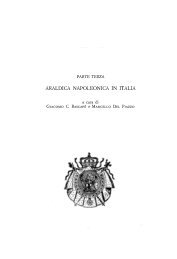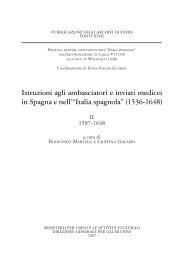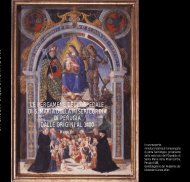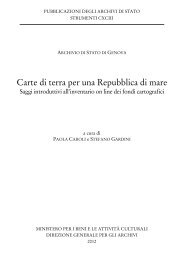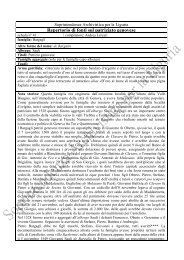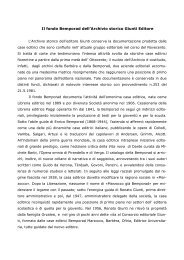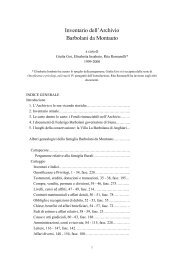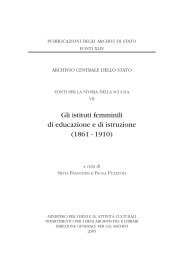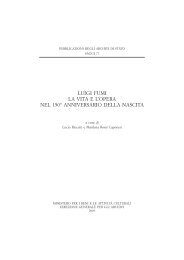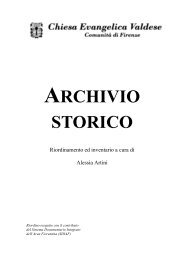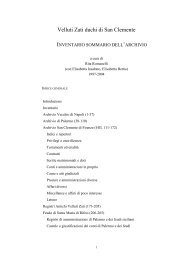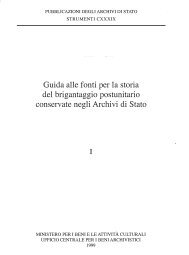esercito e città dall'unità agli anni trenta. tomo i - Sistema ...
esercito e città dall'unità agli anni trenta. tomo i - Sistema ...
esercito e città dall'unità agli anni trenta. tomo i - Sistema ...
Create successful ePaper yourself
Turn your PDF publications into a flip-book with our unique Google optimized e-Paper software.
190 ANTHONY L. CARDOZA<br />
mi quasi d'un altro figlio mio , 16. In a somewhat more direct fashion, Marchese<br />
Carlo Compans di Brichanteau - himself a former officer in the Cavalry<br />
- did no t hesitate to use his substantial influence as a parliamentary deputy<br />
to help his son, Lodovico, embark upon a career in the Cavalry at the turn<br />
of the century 17.<br />
The endogamous tendencies of the Piedmontese nobility ensured that<br />
aristocratic social connections extended well beyond the immediate family.<br />
Indeed, most titled officers from the region were linked and cross-linked<br />
by a series of inter-familial relationships that provided an informai but highly<br />
effective means of communication and mutuai assistance. A sample study<br />
of the marriage patterns of thirty-eight prominent old military families between<br />
1750 and 1914 is rather revealing in this respect. AH the families could<br />
claim at least one marriage to another of the families; twenty-eight of them<br />
were linked by from three to nine marriages to other families in the<br />
group 18. The relationships formed by marriages within such a relatively<br />
small social circle created the basis for a closely knit network in which many<br />
of the men were related to one another as cousins, inlaws, etc. The host<br />
of family ritual an d ceremonial gatherings as well as more casual encounters<br />
in urban palaces or country houses ali afforded opportunities to exchange<br />
news, discuss problems, and seek assistance 19.<br />
Private schools and aristocratic gentlemen's clubs offered additional settings<br />
in which social connections could be developed. The interaction<br />
among aristocratic youths at the Collegio San Giuseppe, the Scuola Sociale,<br />
and the Real Collegio Carlo Alberto reinforced and broadened alliances and<br />
friendships established by marriage and family contact. These schools, which<br />
had supplanted the Accademia Militare as the preferred educational institutions<br />
of the Piedmontese nobility in the late nineteenth century, created a<br />
web of friendships and comradeship among the students that often continued<br />
and served them in their later lives. Thus, both Lodovico Compans di<br />
16 Archivio di Stato, Torino (AST), Prima Sezione, Archivio De Genova di Pettinengo,<br />
Busta 8, Fascicolo 2, letter to Generale Ignazio De Genova di Pettinengo, no date 1890.<br />
17 AST, Sezioni Riunite, Archivio Compans di Brichanteau, Categoria 4, Busta 8 and<br />
12. I8 Information on the marriages within the Piedmontese nobility is drawn from AN<br />
TONIO MANNO, Il patriziato subalpino. Notizie di fatto storiche genealogiche, feudali ed<br />
araldiche, 26 vols. The first two volumes were published in Florence in 1895; the remaining<br />
volumes are in typescript with the originai in the Biblioteca Reale di Torino and<br />
carbon copies at the Biblioteca Nazionale and the AST.<br />
19 For a more generai discussion of the importance of these informai networks, see<br />
ABNER CoHEN, Two-Dimensional Man: An Essay on the Anthropology of Power and Symbolism<br />
in Complex Society, Berkeley 1974, pp. 110-114.<br />
AN OFFICER AND A GENTLEMAN 191<br />
Brichanteau at the Scuola Sociale in the mid-1880s and Ferdinando Morozzo<br />
della Rocca at the Collegio San Giuseppe a decade later encountered<br />
dozens of other boys from prestigious old military families who would accompany<br />
them into the ranks of the officers corps in the ensuing years 20 •<br />
Informai interaction among schoolmates continued after graduation within<br />
the aristocratic confines of the Società del Whist. Founded in 1841 by Cavour<br />
and thirty other Piedmontese nobles, the Whist had as its stated purpose,<br />
" la riunione, in apposito locale, di persone di gentile educazione, le quali<br />
ivi possano trattenersi colla conversazione, con giuochi permessi, e colla lettura<br />
di libri e di giornali , 21 . Well into this century, membership remained<br />
highly restrictive, limited for the most part to men from titled families.<br />
Not surprisingly, most of the names of Piedmontese aristocratic officers in<br />
the Annuari Militari also appear on the Elenchi generali dei soci of the<br />
Società del Whist 22• The dining an d sitting rooms of the Whist offered an<br />
ideai setting for titled officers to renew old friendships and acquaintances<br />
as well as to make new contacts and connections.<br />
The combination of intra-family ties, school friendships, and exclusive<br />
club affiliations gave aristocratic officers privileged access to a wide range<br />
of powerful figures in the military hierarchy, the politica! class, an d at court,<br />
who could be mobilized on their behalf at crucial junctures in their careers.<br />
Even the most cursory reading of his voluminous correspondence reveals<br />
how Marchese Carlo Compans di Brichanteau, for instance, was was constantly<br />
intervening on behalf of an army of relatives and sons of aristocratic<br />
friends w ho w ere seeking some military appointment or assignment 23. It<br />
is difficult to evaluate the effectiveness of these mechanisms of informai influence<br />
on career advancement. They were probably of little help to the<br />
incompetent wastrel, no matter how exalted his famìly name and social connections.<br />
Stili, an analysis of the career patterns of the twenty-nin:e<br />
aristocratic youths who entered the Accademia Militare di Torino between<br />
1861 and 1870 suggests that they were not without effect. Although this<br />
group accounted for less than 4% of the cadets w ho passed through the<br />
Accademia during that decade, fourteen generals and seven colonnels would<br />
2o See AST, Archivio Compans, Cat. 4, B. 10, F. 3, "Alunni dell'Istituto Sociale di<br />
Istruzione ed Educazione ... 1884-85 »; for Morozzo della Rocca, see AST, Archivio Broglia<br />
di Castelborgone, B. 10, distribuzione dei premi, Collegio San Giuseppe, 1896-1902 .<br />
21 Statuto della Società del Whist, Torino 1847.<br />
22 See, for example, Società del Whist. Elenco generale dei socii 1878, Torino 1878,<br />
and similar lists for the years 1897 and 1904.<br />
23 See note 17.



